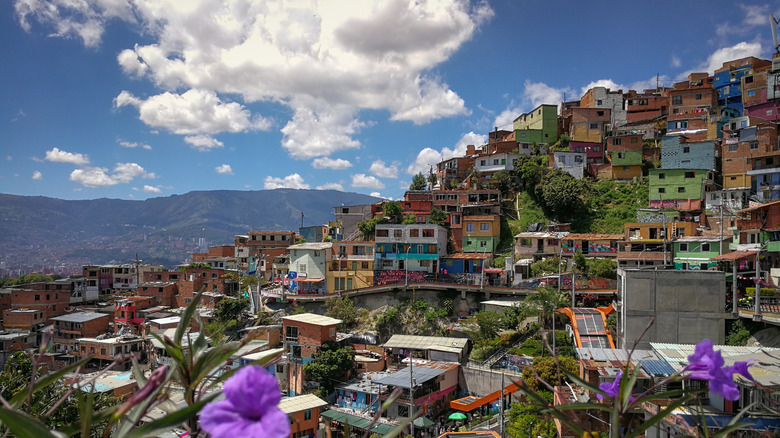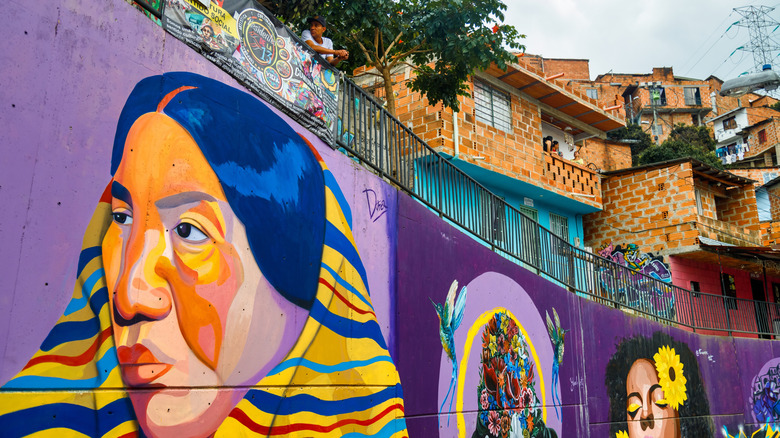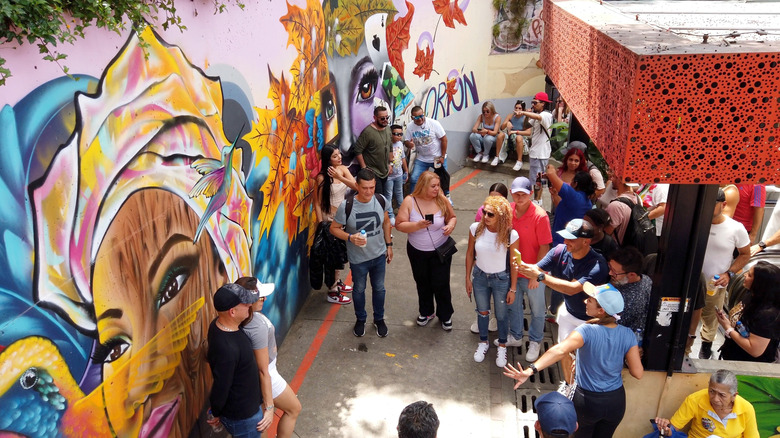One Of South America's Most Dangerous Neighborhoods Has Totally Transformed Into An Artsy Tourist Mecca
Once plagued by extreme violence, drug trafficking, and social exclusion, Comuna 13 (also known as San Javier) is today a colorful hillside community of around 160,000 inhabitants. The comuna clings to a mountainside on the western edge of Medellín, Colombia, the Latin American country considered the best destination for learning Spanish. But how did one of the most dangerous neighborhoods in one of the most dangerous South American destinations transform into one of the city's most sought-after tourist attractions?
The story of Comuna 13 — one of the 16 communes in the city — begins in the late 1960s, when thousands of families from the nearby rural areas fled to the outskirts of the city in search of work and opportunities. Over time these informal settlements grew into a densely-populated neighborhood with little access to infrastructure and services. The rest is history: Isolation and an overall lack of state presence, combined with a strategic position along the narco-trafficking routes, proved a fertile ground for guerrillas and drug cartels, including Pablo Escobar's Cártel de Medellín. Throughout the 1980s and '90s, the area was so dangerous that tourists — and even locals — were explicitly warned to stay away. Surely not a place you'd have wanted to add to your bucket list.
Things started to change in 2002 with Operation Orión, a governmental attempt to eradicate rebel groups from the Comuna. According to official reports, three civilians died in the strike (as well as 10 rebels, two soldiers, and one police officer), though some argue that the actual death toll was much higher. This led to a true social and cultural revolution, with arts and grassroots activism as the main "weapons." The introduction of the iconic orange outdoor escalators, connecting the comuna to the city beneath, further contributed to its present fame as an art and creativity hub.
Comuna 13, colorful murals and breathtaking vistas
Today, Comuna 13 is a must-see when visiting Medellín, also known as South America's "city of Eternal Spring." It's a way to truly get to know its troubled history, engage with the local communities, and enjoy a bird's-eye view over the skyscrapers and heritage buildings of the downtown area (El Centro). These architectural delights include the Romanesque Revival Catedral Basílica Metropolitana and the Gothic Revival Palacio de la Cultura Rafael Uribe, which are beautifully framed by the surrounding Aburrá Valley mountains.
Take one of the escalators climbing the 1,260 feet of the hill — for reference, the Empire State Building is only 1,250 feet tall — and you'll arrive in a neighborhood filled with music, color, and creative energy. Once stained with blood and bullets from brutal gang clashes, the red-brick walls of Comuna 13's homes are now canvases for vibrant graffiti and street art. Each mural tells a story of struggle, resilience, and, above all, hope. A testimony that art can be used as a powerful tool of protest, remembrance, and collective expression.
The most meaningful way to understand the intricate symbolism behind these artworks is through a guided tour led by locals who have lived, endured, and shaped the transformation of the comuna firsthand. It's also a good way to support the rebuilding of the local socio-economic tissue. That said, nothing prevents visitors from exploring Comuna 13 independently.
Rethinking tourism in Comuna 13
While Comuna 13 is no longer one of the most dangerous places on Earth, recent trends reveal the importance of rethinking tourism to balance growth with community wellbeing. In 2024, more than 136,000 tourists flocked each month to popular spots such as Las Independencias and 20 de Julio. Some sources, such as student travel tour operator CAS Trips, suggest that illicit activities are slowly resurfacing, largely due to overtourism and the absence of effective government regulations. Meanwhile, concerns for residents' quality of life are also mounting, with relentless noise, rising housing prices, and the proliferation of unauthorized vendors among the most pressing issues.
As happened in the past, the Comuna 13 community has once again proved stronger than the challenges it faces, putting in place informal yet effective agreements to protect residents from the pressures of gentrification and to keep housing affordable and accessible. Notably, these agreements discourage short-term rentals and advocate for daytime-only operating hours for businesses. As outside visitors, we too can play our part by supporting sustainable tourism practices and prioritizing experiences that uplift local voices.


